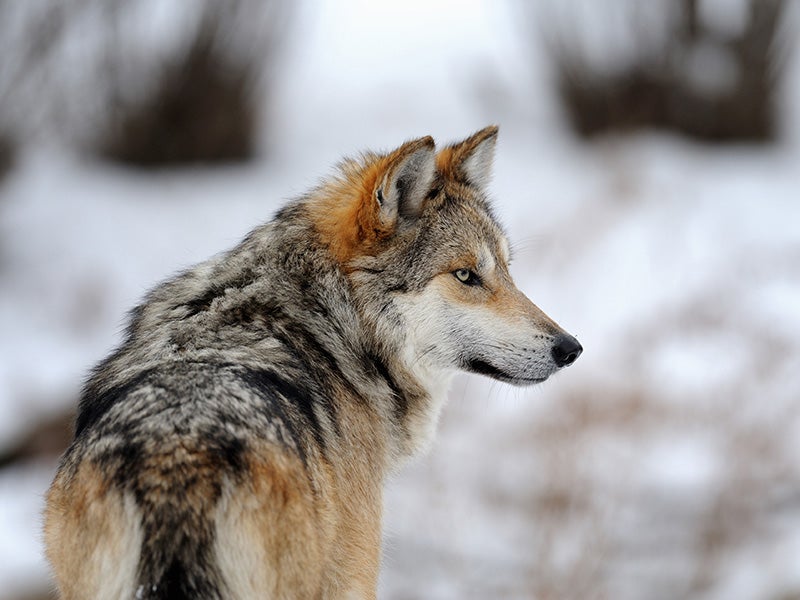Conservationists Take Aim at Flawed New Rule on Mexican Gray Wolf Management
Changes unjustifiably cap wolf population at 325, preclude recovery north of I-40, loosen restrictions on killing wolves
Contact
Conservationists say they’ll fight provisions in a new federal rule that caps the population of endangered Mexican gray wolves in the Southwest at numbers too low for recovery, bans them from needed recovery habitat, and makes it easier for them to be killed. While the U.S. Fish and Wildlife Service’s new rule allows wolves in an expanded area, the other provisions will impede the long-term recovery of these rare animals. (Update, January 16, 2015: Earthjustice, on behalf of Center for Biological Diversity and Defenders of Wildlife, filed a lawsuit fighting provisions in the new rule that unjustifiably cap wolf population at 325, preclude recovery north of I-40, and loosen restrictions on killing wolves.)
The Service also announced today that it will protect the Mexican wolf under the Endangered Species Act as a subspecies separate from other wolves, which will provide Mexican wolves the right to a long-delayed recovery plan. Both new rules stemmed from petitions and lawsuits filed by the Center for Biological Diversity.
“The Mexican gray wolf recovery program has been hamstrung from the start, and this new management rule doesn’t go nearly far enough to fix the problem,” said Michael Robinson of the Center for Biological Diversity. “Capping the population and keeping them out of the Grand Canyon and northern New Mexico will keep the lobo on the brink of extinction.”
“The Fish & Wildlife Service’s new rule offers some useful reforms, but it ultimately overwhelms them with harmful ‘poison-pill’ provisions that conflict with prevailing scientific recommendations and that will make it impossible to recover this extremely rare and embattled species,” said Heidi McIntosh, Earthjustice managing attorney. “The Mexican wolf’s climb back from the brink of extinction is hard enough without placing new obstacles in their way.”
As documented in a recently issued report, blocking the wolves at Interstate 40 runs directly counter to the recommendations of the Service’s own recovery team and the best available science. That recovery team determined that additional Mexican wolf populations should be established in the Grand Canyon ecosystem and in northern New Mexico and southern Colorado to help increase wolf numbers to at least 750 animals.
The new rule also gives the Service great latitude to issue permits to private individuals and government agents to kill wolves without any safeguards to guarantee that such killing will not remove genetically essential individuals from the Mexican wolf population, which is already under threat of genetic inbreeding.
“Allowing Mexican gray wolves to disperse over a broader area is a positive, but that positive is negated by an unfounded population cap and increased authorized killing—neither of which is based in the science that says what’s best for lobos,” said Eva Sargent of Defenders of Wildlife. “The rule is a classic ‘one step forward, one or two steps back’ and will ultimately hinder the recovery of these iconic and imperiled wolves.”
Background
The Mexican gray wolf is one of the most endangered mammals in North America. At last count a year ago, only 83 Mexican wolves survived in the Southwest, including a mere five breeding pairs; another count is ongoing now to determine 2014 numbers. Scientists have shown that inbreeding caused by a lack of wolf releases to the wild, coupled with too many killings and removals of wolves, is causing smaller litter sizes and lower pup-survival rates in the wild population.
The previous rule guiding management of Mexican wolves, issued on Jan. 12, 1998, allowed release of captive-bred wolves into a small area of Arizona but not New Mexico. The new rule will allow release of captive-bred wolves into the Gila and portions of the Cibola (New Mexico), Sitgreaves and Tonto (Arizona) national forests, and will allow wolves to roam from the Mexican border north to I-40 in New Mexico and Arizona, but no farther.
Expanding wolf releases to New Mexico’s Gila National Forest, in particular, will enable managers to diversify the population through new releases, as well as diminish inbreeding. The Fish and Wildlife Service acknowledged the need for this change in reviews conducted in 1999, 2001, 2005 and 2010; the American Society of Mammalogists in 2007 likewise urged its enactment.
However, the new rule ultimately negates the benefit of this reform through enactment of measures that:
- Cap the reintroduced population at 325 wolves, a level that scientists have demonstrated to be too low for long-term survival, let alone recovery;
- Bar wolf dispersal north of I-40, where essential recovery habitat for the species is located;
- Expand opportunities for killing wolves without any safeguards in place to prevent the loss of genetically important individuals.
These measures, by themselves and cumulatively, threaten to prevent recovery of the Mexican gray wolf, consigning the species to a perpetual battle for survival.
A 2004 petition for rulemaking by the Center for Biological Diversity, coupled with lawsuits in 2006 and 2012, led to today’s rule.

Additional Resources
About Earthjustice
Earthjustice is the premier nonprofit environmental law organization. We wield the power of law and the strength of partnership to protect people's health, to preserve magnificent places and wildlife, to advance clean energy, and to combat climate change. We are here because the earth needs a good lawyer.